|
Manipur: The Switzerland of India
Described by Lord Irwin as the 'Switzerland of India', Manipur boasts of an exotic landscape with gently undulating hills, emerald green valleys, blue lakes and dense forests. It is the sheer tranquility enveloping it, interrupted only by a soft breeze that sets it apart from the other northeastern states, and makes it the ideal getaway. Manipur, literally meaning the land of jewel, is a paradise on earth when Mother Nature has been extra generous in her beauty. And from the very inception, this princely state of Manipur has always been a shinning outpost of the country in the sparse of the eastern Himalayas. It never lost its basic link with the mainstream of the Indian culture.
In the
Mahabharata, the country is mentioned as Meckley. In 1876 A.D. the King of Manipur used the same name referred to his Kingdom which is documented in the treaty with the British Government. In the old Assamese records, Manipur is mentioned as
Magloo or Moglai country. In Sylhet and Cachar the Manipuris are called as the
Mei-Moglais in common parlance. The Burmese call the country as Cassey or
Kassey.
[
Top
]
Manipur: The meeting place of Arjuna and Chitrangada
In the Ashwamedha Parba of the Mahabharata, it is referred Manipur a splendidly
beautiful,The people are well cultured and religious minded
exclusively attached to Lord Vasudeva Krishna who is always in their thought.
The striking aspect of Manipur, however, is its breath taking scenic beauty.
Imphal, the capital city, is surrounding by hills a Nongmaijing or
Mahendra Parabata in the east and Longol in the north.[
Top
]
|
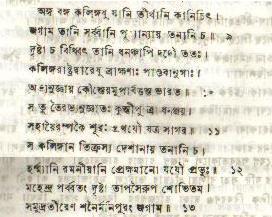
|
|
|
ByasaDeva's
Mahabharata ( Sloks 9 -13, chapter 211, Adiparva )
States that Manipur was the meeting place of Arjuna, The third Pandava
and Chitrangoda , the crown princess of Manipur.
|
|
In the Mahabharata, Manipur is mentioned as the meeting place of Arjuna, the third
pandava and Chitrangada, the crown Princess of Manipur. Besides, there
are numerous genealogy prevailing in Manipur relating the lands as reclaimed from water by Lord Siva’s
Trisul, while another lined makes it the place illuminated by the jewel on the crown of
Shesh Nag for Lord Shiva and Goddess Parvati to play Rasleela after
sunset. Spurred by the example of Lord Krishna and Srimati Radhika immersed in
Rasleela, their privacy guaranteed by Lord Siva as the gatekeeper, Goddess
Parvati had requested Lord Siva dance with her. The myth and lore of Manipur refers to the
supreme deity or Dau Seidaba rubbing hands to create from the Gods and Goddesses the human being to people the new land
Manipur. [
Top
]
Whether The Present Manipur is that of the Epic
However, scholars have different opinions as well as views regarding the exact location of the
Mahabharatiya Manipur with that of the present Manipur of the North-east India. Dr.P.C.Choudhuri
identifies Mareura with Manipur. Dr. Choudhuri says that “in the prehistoric period, some of the hilly regions may have been under water and some of the
pains were higher than that we find today. Sasiya, for instance, must have been an island surrounded by water and
Manipur may have been lake and flat valley.”On the other hand G. E.Geraini, in his work, Researches on
Ptolemy's Geography, States that " Bishnupur was the ancient capital of Manipur and Imphal locally known as kangla or kangleipak was the capital of the Meitei Leipak of the later period which finds mentioned in the Meitei
purana, i.e. Bijoy panchalee." So, Imphal come into existence in much later period than that of the city of Bishnupur as stated by Prof. Padmanath
Battacharjee.
|
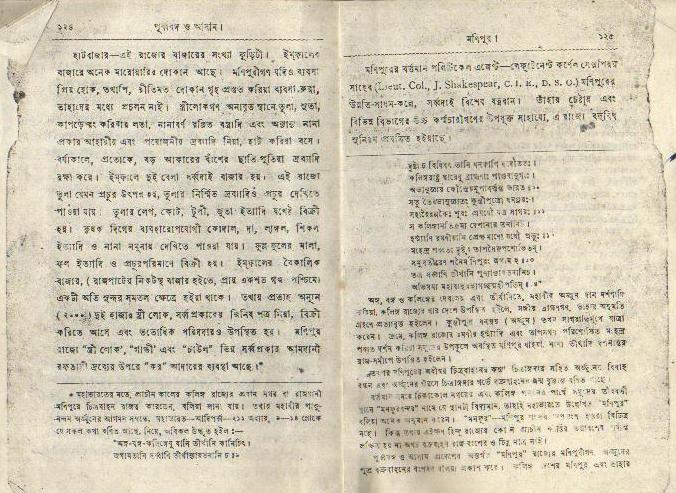
|
|
|
Page
124-125 of Purbabango O Assam, 1909 by Shri Krishnamohon Dhar.
Other Bengali Scholars and historians like Dr. Dinesh
Chandra Sen, Shri Ochchutcharan Chaudhury, Shri Janokinath Bosak
also supported the fact of present Manipur to be that of the epic in their writings and
articles
|
|
McCulloch described that “ The name Manipour accounted for by the
Munniporie, who quote the Mahabharata in confirmation of its accuracy. They gave the same form Muni, a jewel. This jewal formerly in the possession of the
Rajas of the country ages ago. The country was at one time named Mahindrapore, but one Rajah
by the name Manipur was in existence before the birth of Babhrubahana, and
Mahindrapore or Mahindra Parbhata was the name of the hill, situatd but a short distance to the east of the
capital”. While commenting on the name of country, R.N.Nath states that the small kingdom of Manipur is ssituated on the eastern border of Assam on a table and surrounded by hills on all sides. It has a very large lade named
Loktak, about 8 mailes lond, 5 miles wide having floating island on it. [
Top
]
|

|
|
|
The evidences of
KurmaPurana show that Chitrangada pleases Lord Siva through her worship. And
the place where she worshiped Lord Siva, became a holy place where Vyasa
himself paid a visit.
|
|
Meitei Puran Bijoy Panchali states - "Chanting 'Omkar', Sannskrit language, now
obsolete, and Vedic rituals
were prevailing in Manipur. As such the race of people inhabiting Manipur was distinctly Aryan"(Edited by L. Mani singh and Shri Mangi Singh /English translation from part II Page 138). Referring to the people of Manipur
E.T. Dalton in his book Descriptive Ethnology of Bengal, states that, " And, this hordes overrun a country( Manipur) that has been previously occupied by the [
Top
]
|

|
|
|
Dharani
Sanghita ( part 4, Narad-Janmejoy talks ) also narrates the beauty of
Manipur and the devine love story of Arjuna and Chtrangoda
|
|
people of Aryan blood known in the western India and to the Bards." While explaining the appearance of the
maipuris, Dr. Brown says " although the general facial characteristics of the Mannipurie are of Mongolian type, there is great diversity of fetures among them, some of them showing regularly approaching the aryan type". in Assam District
gazeteer, Part -IX V.C Elen reports that " ...the vally was originally occupied by several tribes principals were
Khumal, Luwang, Moirang and Meitai all of whom [
Top
]
|
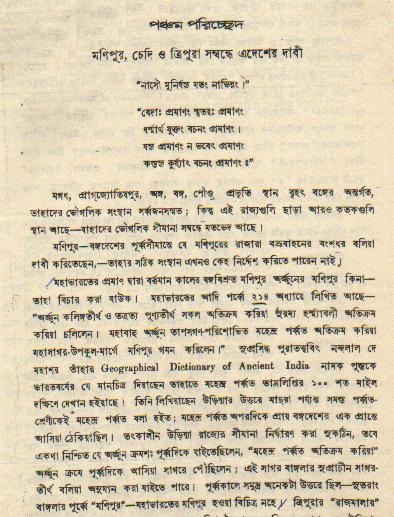
|
|
|
Page
31,32,1096,1097,1098 of Brihod Banga ( Kolkata,1935 ) by
Dinesh Chandra sen, gives the some proofs about the Epic Manipur of
Mahabharata
|
|
came from different quarters of whom
khumals are the most powerful and after them the Moirangs but ultimately the Meitais subdued them and form them into a single
people. So,
Manipur, the ancient Aryan Land ruled by Indo-Aryan people for several centuries. If we talk of the history in respect of the
Aryan population, their migration, settlements and cultural penetration and the development
of political institutions in Manipur Valley, there are a little source of information's
about this. Ancient temples like the Vishnu temple of Bishnupur, Govindajiew temple in
imphal, the Kohima stone, old palaces and other related buildings etc. supply us little more historical
information's. Furthermore, the establishment of an indo-Aryan [
Top
]
|

|
|
|
The
relation between Lord Shiva and Goddess Parvati with the holy land
wasdescrobed in the
Assam Khanda, Page 42 by Dr. Anuradha Banarjee
|
|
state in the remote period in Manipur in indicated by
Geraini, " From the Brahmaputra and Manipur to the tonkin gulf, we can trace a continuous string of petty states ruled by those scions of the ksatriyo race, using the sanskrit or pali language in official documents and
inscriptions, buildings, temples and monuments of old Hindu style and employing Brahmin priests at the propitiatory ceremonies connected with the court, and the
state.
|
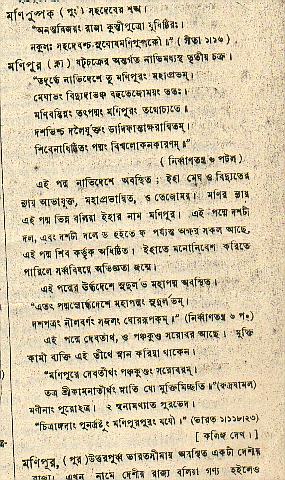
|
|
|
Page 722 from
Biswakosh (Encyclopedia Indica, vol XIII, 1309, Bangla) by Sri
Nagendranath Basu
|
|
Scholars like Dr. Dinesh Chandra Sen( Brihod Bongo, 1935), Shri Ochchutcharan Chaudhury (
Srihotter Itibritta, 1905, ), Shri Janokinath Bosak( Manipur
prohelika), Shri Sena singha( Prachinadhunik Somkhipta monipurer Itihas),Shri Mukundalal Chowdhury (
Manipurer Itihas), Shri Mohendra Kumar Singha ( Manopurer Prachin
Itihas),Shri Krishnamohon Dhar (Purbabango O Assam, 1909) also supported the fact of present Manipur to be that of the epic in their writings and articles. [
Top
]
|
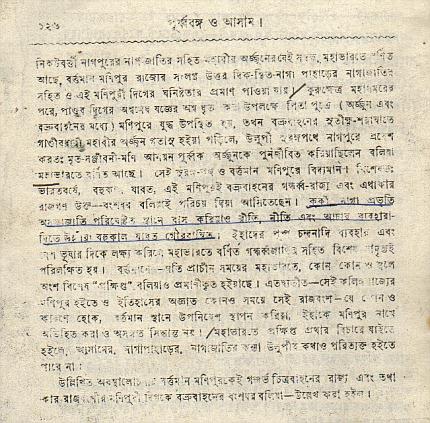
|
|
|
Sri
KrisnaMohan Dhar, writer of Purbabanga o Assam ( 1909) mentioned clearly
the connection of present manipur to that of the epic, mighty Arjuana,
Chitrangoda and Babhrubahana.
|
|
Moreover, the geographical location of the Manipur Valley gives it a partial isolation from the mainland for a long period in the past. It was only after the advent of the Aryans in the valley ages ago, it adopted open door policy to all and soon it became a part and percale in the Indian panorama.
[ Top
]
Physiography
The present State of Manipur is geographically bounded by Nagaland in the North, Mizoram in the South, Cachar district of Assam in the West and bordering
Burma in the East.
The land surface of Manipur is 22,347 sq. kms. And about 90% of the land is mountainous. Its rain varies
between 2600 to 3350 meters. It has also an enjoyable climate almost throughout the year and free from the rihours of both summer and winter.
The rivers also served as the important waterway link with different parts of Manipur valley connection
Imphal, the capital city. The major river of the land is known as Imphal after which the capital city was named. The other
rivers smaller than the Imphal are the Iril, thoubal, Irnag, Nambul etc. Other smal
ltributaries, viz. Jiri and Chiri constitute the river Bairad of Borak.
Manipur’s sceneric beauty, lake and water resources, craftsmanship etc. are encompassed and picturesque. It is ful of various orchids. Manipur is also famous for its dances and rare and beautiful exquisite handicrafts. It has its famous Vishnu Mandir at Bishnupur of Bishenpur, Govinda Mandir at Imphal, and the
Loktak
lake, the biggest fresh water lake in India. Presently, the lake is projected with a Hydro-Electric power plant. The Rathband Bazar of Thangal Bazar of Khuwai at Imphal is administered entirely by the women folk and is the largest Asin market of its kind. Keibul Lamijao is the only floated national park located in Manipur. The Orchid yard of Khongapat is
attractive as well as famous
too.[
Top
]
People and Culture
The people are simple and happy. They speak sweet words. The place is the land of diverse origins, but of a unique culture. Here different ethnic groups of people are living together for centuries with peace and harmony. Majority people of the State are the Manipuris. They are again sub-divided into two racial and linguistic groups namely :
Bishnupriya Manipuri and Meitei. The former group of the people traced their ancestry with the
Arjuna Chirangoda Babhrubahana episode of the Mahabharata and claiming to be the
Kshatriyas of the Aryans origin while the later section identified themselves as the
Kuki-Chin branch of the Mongolian stock. The Hill tribes of Manipur although divided into a number of clans and sections, maybe grouped under the two divisions -Naga's and
Kuki's.
|
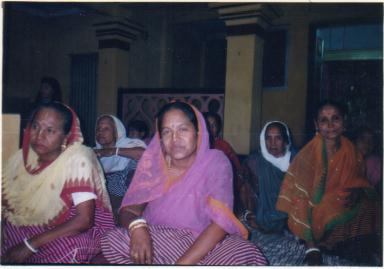
|
|
|
Although
the general facial characteristics of the Mannipurie are of
Mongolian type, there is great diversity of fetures among them, some of them showing regularly approaching the aryan
type"(Imperial gazetteer of India, 1908, Vol 17, page 126) |
|
Manipur is a mosaic of traditions and cultural patterns, best represented by its dance forms. The
Lai-Haraoba, a traditional stylized dance is ritual dance for appeasing gods and goddesses. The
Lai-Haraoba festival is generally celebrated between April and May, after the harvest season, The Ras songs and dances express the
Leelas (sports) of Lord Krishna as a child with the Gopis milkmaids) of
Brindavan, and depict their yearning for communion with the Lord. The tribal dances of Manipur are the expression of love, creativity and aestheticism of the tribal people of the State. Manipuris were earlier recognized as skilful warriors and still practice the arts of wrestling, sword fighting and martial arts.
Sogol Kangiei (Mainipuri Polo) is the principal sport of the State, for polo is believed to have originated here.
Mukna Kangiei (Wrestling Hockey) is also a very popular game in Manipur. The game is part of a ceremonial function and enjoyed due patronage in the olden days. Another popular game known as
Yubi-Lakpi (Manipur Rugby) is played, using a greased coconut. [
Top
]
The Sriroy Lily
It is grown at the peak of the Shiroy Kashang Mountain at a height of 8400 feet above sea level situated in Ikhrul district of Manipur.
The Shiroy Lily belongs to Lilium family, but unique in character. By using a microscopic lens, seven colours which claimed its superiority to
other lilies in the world can be seen light pink in color. The height of the plant varies from 2 ft. to 31/2ft. depending on the soils fertility
Shiroy Lily is not grown anywhere in the world accept Shiroy Kanhong of Manipur.
|

|
|
|
Sriroy Lily |
|
It is said that Priincess Chitrangoda of Manipur had own the heart of Arjuna in her first meeting by offering a Shiroy Lily. Arjuna was so impressed with the beauty and fragrance of the flower that he at once lost himself on her.
This Shiroy Lily starts blooming during the months of May-June every year on the laden mineral mountain of the Shiroy. It was discovered first by a
British naturalists Mr. Kingdom ward, who gave it the Botanical name Lilium Mackleanae and won him the show in London in the 1948.
[
Top
]
Administrative Units
Manipur was an independent princely State earlier. In 1891, it become a British
protectorate. The State later on merged with the union of India on October 15, 1949. It was than
categorized a ‘C’ group state on January 26, 1960 and finally on January 21, 1972. She got her full
Statehood within constitutional limits of India.
Presently, it is divided into eight administrative units, i.e. districts. These are again
distributed as Valley Districts consisting of Bishnupur or Bishenpur, Imphal and Thoubal and Hils Districts includes Ukhrul, Senapati, Tamenglong, Churachandpur and Candel. Besides,
there are nine other important towns and about 2089 villages in the state. It has six Autonomous District Councils. They are Tengnoura Autonomous District Council. Sadar Hills Autonomous District Council, Manipur North Autonomous District Council, Manipur South Autonomous District Council, Manipur East Autonomous District Council and Manipur West Autonomous District Councils. All these administrative units are well and properly connected with the State Administration. Imphal the capital city of the State of Manipur is the largest and an
important city having over one and a half lakh population. The
population of Bishnpur and Moirang are 1,79,903 ( Males: 90415 and Females : 89,488) as in 1993
census.[
Top
]
The State Symbol
The State symbol or emblem of Manipur is Kanglasha ( Nongsaba), i.e. half lion and half dragon. Sangai or brown antlered deer is the State animal, while Nongin remained as the State bird. Iningthiu is regarded as the State tree and the world famous Shiroy Lily ( Lilium) is the State flower of Manipur. Friday, January 21 (1972) is the Statehood day and Date of Manipur.
[
Top
]
Source:
Bidhan Singha - Cultural Heritage of North-East India,
Guahati, 1999
Dr. Dinesh Chandra Sen( Brihod Bongo, 1935),
Shri Ochchutcharan Chaudhury (
Srihotter Itibritta, 1905, )
Shri Janokinath Bosak( Manipur
prohelika),
Shri Sena singha( Prachinadhunik Somkhipta monipurer Itihas),
Shri Mukundalal Chowdhury (
Manipurer Itihas),
Shri Mohendra Kumar Singha ( Manopurer Prachin
Itihas),
Shri Krishnamohon Dhar (Purbabango O Assam, 1909)
Bhimsen
Singha - Let History and Facts speak about Manipuris, Silchar 1984
[
Top
]
|
Manipur
Profile
|
| Location |
- |
North East
of India |
| Capital |
- |
Imphal |
| Area |
- |
22,347
Sq.Km. |
| Population |
- |
18,37,149 (as per 1991 census) |
| The
People |
- |
Meiteis,
Loi or Chakpa, Yathibi, Bishnupriya Manipuris and Some Hill Tribes. |
| Languages
Spoken |
- |
Meitei,
Bishnupriya Manipuri, Hindi, English, Mizo, Nepali and local dialects. |
| State
Emblem |
- |
Kangla
Shaa |
| Major
Religions |
- |
Hinduism,
Christianity, Islam and Senamahism |
| Literacy
rate |
- |
60 %
(1991) |
| Density
of Population |
- |
82 ( per
sqr km ) |
| Major
Rivers |
- |
Imphal,
Iril, thoubal, Irnag, Nambul |
| Urbanization
rate |
- |
27.69% |
| State
Domestic Product |
- |
Rs. 7610
Mln. (1991-92) |
| Per
capita State Income |
- |
Rs. 4,180
(1991-92) |
| Tourism |
- |
Imphal,
the beautiful capital city in the valley; Mao and Ukhrul,
the picturesque hill resorts; Taminglong, with its exotic
landscape; Chandel, home to amazing tribes; Khonggom
and Moirang, reminders of the British Raj in India. |
| Entry
Formalities |
- |
Inner
line permit is required by Domestic Tourists and Restricted
Area Permit is required by Foreign Tourists. |
[
Top
]

Revised: July 04, 2002
Copyright © 2000,2001,2002 Ashim
Singha All rights reserved.
|










